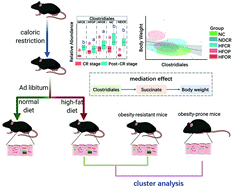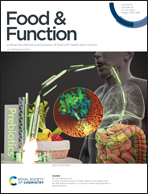Calorie restriction on normal body weight mice prevents body weight regain on a follow-up high-fat diet by shaping an obesity-resistant-like gut microbiota profile†
Abstract
Calorie restriction (CR) is one of the most common approaches for obesity treatment, but whether resuming ad libitum feeding after CR in normal-weight mice can affect excessive weight regain remains poorly studied. To address this issue, male C57BL/6 mice were placed in three groups: a control group (n = 10), a group fed normal diet with 30% CR (n = 20); and a group fed a HF diet (n = 30). After four weeks, the CR group was fed either a normal diet (NDCR, n = 10) or a high-fat diet (HFCR, n = 10) for an additional eight weeks. At the end of the experiment, mice in the HF group ranked in the upper and lower thirds for weight gain were designated as obesity-prone (HFOP, n = 10) and obesity-resistant (HFOR, n = 10), respectively. CR delayed weight regain and visceral fat accumulation. Gut microbiota in the HFCR group were more similar to the HFOR group than the HFOP group, mainly due to reversion of the decreased level of Clostridiales induced by CR. Mediation analysis showed that Clostridiales may delay body weight regain by affecting the interconversion of succinate and fumarate. Random forest and structural equation analyses showed Christensenellaceae were the most important biomarker for alleviation of obesity. In conclusion, CR shapes an obesity-resistant-like gut microbiota profile that may attenuate body weight regain.



 Please wait while we load your content...
Please wait while we load your content...